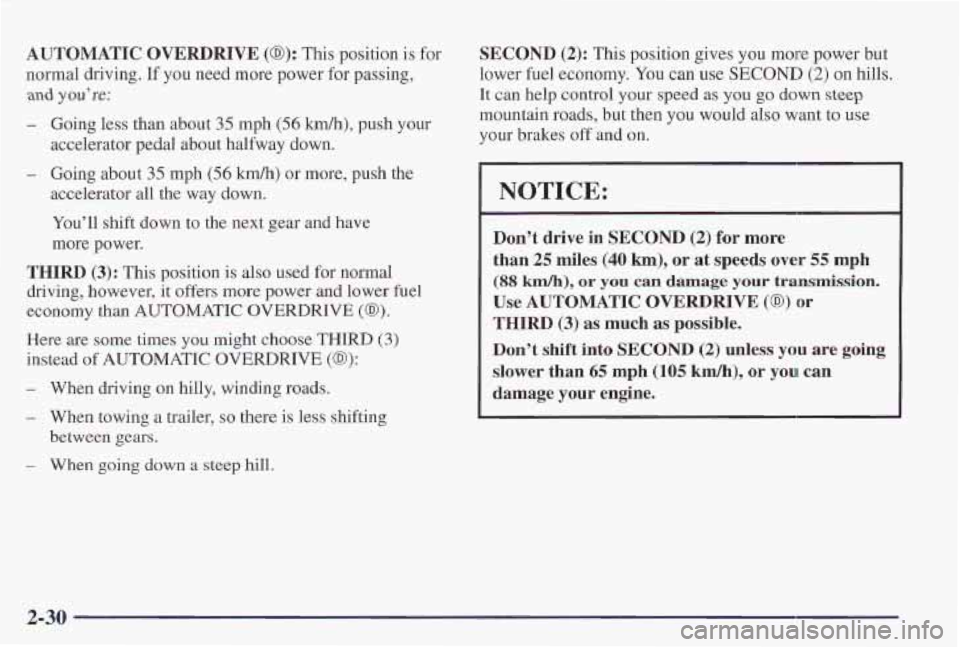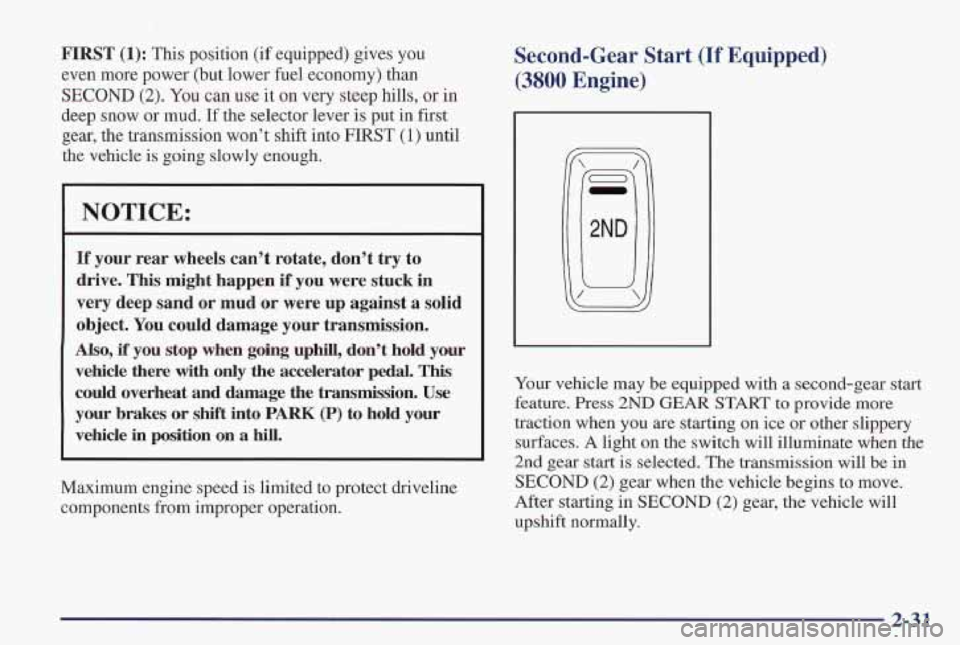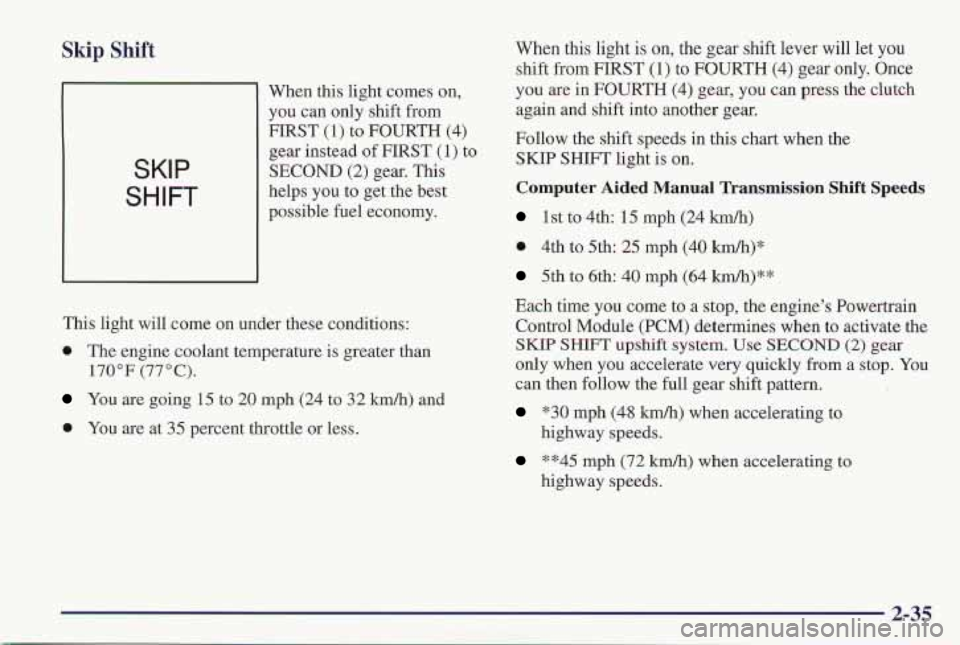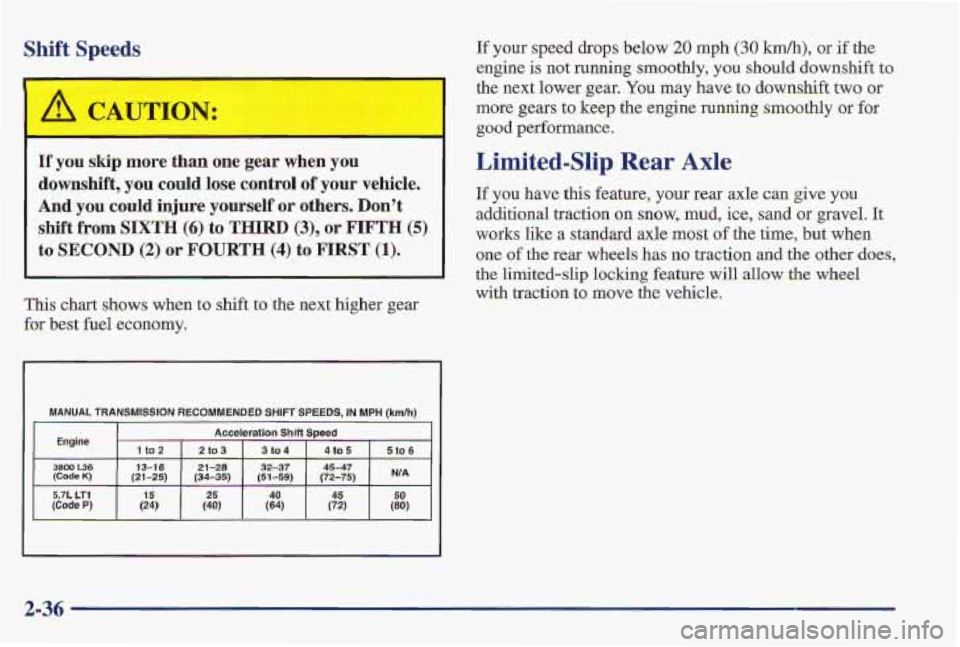engine PONTIAC FIREBIRD 1997 User Guide
[x] Cancel search | Manufacturer: PONTIAC, Model Year: 1997, Model line: FIREBIRD, Model: PONTIAC FIREBIRD 1997Pages: 410, PDF Size: 19.2 MB
Page 77 of 410

Automatic Transmission Operation
There are several different positions for your shift lever.
PARK (a): This locks your rear wheels. It’s the best
position
to use when you start your engine because your
vehicle can’t move easily,
It is dangerous to get out of your vehicle if the
shift lever
is not fully in PARK (P) with the
parking brake firmly set. Your
vehicle can roll.
Don’t leave your vehicle when the engine is
running unless you have to. If you have left the
engine running, the vehicle can move suddenly.
You or others could be injured. To be sure your
vehicle won’t move, even when you’re on
fairly
level ground, always set your parking brake and
move the shift lever to PARK (P).
See “Shifting Into PARK (P)” in the Index. If
you’re pulling a trailer, see “Towing a Trailer” in
the Index.
2-28
Page 78 of 410

Ensure the shift lever is fully in PARK (P) range before
starting the engine. Your Pontiac has a
Brake-Transmission Shift Interlock.
You have to fully
apply your regular brakes before you can shift from
PARK
(P) when the ignition key is in the RUN position.
If you cannot shift out of PARK (P), ease pressure on
the shift lever
-- push the shift lever all the way into
PARK (P) and also release the shift lever button on floor
shift console models as
you maintain brake application.
Then move the shift lever into the‘gear you wish. (Press
the shift lever button before moving the shift lever
on
floor shift console models.) See “Shifting Out of
PARK,
(P) in this section.
REVERSE (R): Use this gear to back up.
I NOTICE:
Shifting to REVERSE (R) while your vehicle is
moving forward could damage your
transmission. Shift to
REVERSE (R) only after
your vehicle is stopped.
To rock your vehicle back and forth to get out of snow,
ice or sand without damaging your transmission, see
“Stuck: In Sand, Mud, Ice
or Snow” in the Index.
NEUTRAL (N): In this position, your engine
doesn’t connect with the wheels.
To restart when you’re
already moving, use
NEUTRAL (N) only. Also, use
NEUTRAL (N) when your vehicle is being towed.
A 1
A CAUTION:
Shifting out of PARK (P) or NEUTRAL (N) while
your engine
is “racing” (running at high speed) is
dangerous. Unless your foot is firmly on the
brake pedal, your vehicle could move
very
rapidly. You could lose control and hit people or
objects. Don’t shift out of PARK (P) or
NEUTRAL
(N) while your engine is racing.
NOTICE:
Damage to your transmission caused by shifting
out of PARK
(P) or NEUTRAL (N) with the
engine racing isn’t covered
by you warranty.
2-29
Page 79 of 410

AUTOMATIC OVERDRIVE (0): This position is for
normal driving.
If you need more power for passing,
and you’re:
- Going less than about 35 mph (56 kdln), push your
accelerator pedal about halfway down.
accelerator all the way down.
You’ll shift down to
the next gear and have
more power.
- Going about 35 mph (56 kdh) or more, push the
THIRD (3): This position is also used for normal
driving, however, it
offers more power and lower fuel
economy than
AUTOMATIC OVERDRIVE (@).
Here are some times you might choose THIRD (3)
instead of AUTOMATIC OVERDRIVE (0);
- When driving on hilly, winding roads.
- When towing a trailer, so there is less shifting
between gears.
- When going down a steep hill.
SECOND (2): This position gives you more power but
lower
fuel economy. You can use SECOND (2) on hills.
It
can help control your speed as you go down steep
mountain roads, but then you would also want to use
your brakes
off and 0n.
Don’t drive in SECOND (2) for more
than
25 miles (40 km), or at speeds over 55 mph
(88 km/h), or you can damage your transmission.
Use AUTOMATIC OVERDRIVE (@) or
THIRD (3) as much as possible.
Don’t shift into SECUND (2) unless you are going
slower than 65 mph (105 km/h), or you can
damage your engine.
2-30
Page 80 of 410

FIRST (1): This position (if equipped) gives you
even more power (but lower fuel economy) than
SECOND (2). You can use it on very steep hills, or in
deep snow or mud. If the selector lever is put in first
gear, the transmission won’t shift into
FIRST (1) until
the vehicle is going slowly enough.
NOTICE:
If your rear wheels can’t rotate, don’t try to
drive. This might happen if you were stuck in
very deep sand or mud or were up against a solid
object. You could damage your transmission.
Also, if you stop when going uphill, don’t hold your
vehicle there
with only the accelerator pedal. This
could overheat and damage the transmission. Use
your brakes or shift into
PARK (P) to hold your
vehicle in position on
a hill.
Maximum engine speed is limited to protect driveline
components from improper operation.
Second-Gear Start (If Equipped)
(3800 Engine)
Your vehicle may be equipped with a second-gear start
feature. Press 2ND GEAR START to provide more
traction when you are starting on ice
or other slippery
surfaces.
A light on the switch will illuminate when the
2nd gear start
is selected. The transmission will be in
SECOND (2) gear when the vehicle begins to move.
After starting
in SECOND (2) gear, the vehicle will
upshift normally.
2-31
Page 81 of 410

This feature is for improved traction only ,when the road
surface is slippery and is not intended for continuous use
or when the vehicle is stuck in sand, mud, ice, snow or
gravel. Always use
NORMAL for normal road
conditions. You may press the 2ND GEAR START
switch again to turn
off this feature. The light on the
switch will
go out. Whenever you start your vehicle, the
transmission is in the NORMAL
mode.
Manual Transmission
5-Speed
1 3 5
2 4 R
This is your shift pattern.
Here’s how to operate
your transmission:
FIRST (1): Press the clutch pedal and shift into
FIRST (1). Then slowly let up on the clutch pedal as
you press the accelerator pedal.
You can shift into FIRST (1) when you’re going less
than
20 mph (32 km/h). If you’ve come to a complete
stop and it’s
hard to shift into FIRST (l), put the shift
lever in NEUTRAL
(N) and let up on the clutch, Press
the clutch pedal back down. Then shift into FIRST
(1).
SECOND (2): Press the clutch pedal to the floor as
you let up on the accelerator pedal and shift into
SECOND
(2). Then, slowly let up on the clutch pedal as
you press the accelerator pedal.
THIRD (3), FOURTH (4), and FIFTH (5): Shift into
THIRD
(3), FOURTH (4) and FIFTH (5) the same way
you
do for SECOND (2). Slowly let up on the clutch
pedal as
you press the accelerator pedal.
To Stop, let up on the accelerator pedal and press the
brake pedal. Just before the vehicle stops, press the
clutch pedal and the brake pedal, and shift to
NEUTRAL
(N),
NEUTRAL (N): Use this position when you start or
idle your engine.
2-32
Page 83 of 410

SECOND (2): Press the clutch pedal as you let up on
the accelerator pedal and shift into
SECOND (2). Then,
slowly let up on the clutch pedal as you press the
accelerator pedal.
THIRD (3), FOURTH (4), FIFTH (5) and
SIXTH (6): Shift into THIRD (3), FOURTH (4),
FIFTH (5) and SIXTH (4) the same way you do for
SECOND (2). Slowly let up on the clutch pedal as you
press the accelerator pedal.
To Stop, let up on the accelerator pedal and press the
brake pedal. Just before the vehicle stops, press the
clutch pedal and the brake pedal and shift to
NEUTRAL
(N).
NEUTRAL (N): Use this position when you start or
idle your engine.
REVERSE (R): To back up, press down the clutch
pedal and shift into
REVERSE (R). Let up on the clutch
pedal slowly while pressing the accelerator
pedal. If you
shift from SIXTH (6) into REVERSE (R), the shift lever
must
be first placed in NEUTRAL (N) position centered
between
SECOND (2) and THIRD (3) prior to shifting
into REVERSE (R).
Your six-speed manual transmission has a feature that
allows
you safely to shift into REVERSE (R) while the
vehicle is rolling at less than
5 mph (8 km/h). You will
be locked-out
if you try to shift into REVERSE (R)
while your vehicle is movins fa ’ :r than 5 mph
(8 km/h).
If you have turned your ignition off and want to park
your car
in REVERSE (R), you will have to move the
shift lever quickly to the right, then forward into gear.
2-34
Page 84 of 410

Skip Shift
SKIP
SHIFT
When this light comes on,
you can only shift from
gear instead of FIRST
(1) to
SECOND
(2) gear. This
helps you
to get the best
possible fuel economy.
FIRST
(1) tQ FOURTH '(4)
This light will come on under these conditions:
0 The engine coolant temperature is greater than
You are going 15 to 20 mph (24 to 32 km/h) and
0 You are at 35 percent throttle or less.
170°F (77°C).
When this light is on, the gear shift lever will let you
shift from FIRST (1) to FOURTH (4) gear only. Once
you are in FOURTH (4) gear,
you can press the clutch
again and shift into another gear.
Follow the shift speeds in this chart when the
SKIP SHIFT light is on.
Computer Aided Manual Transmission Shift Speeds
1st to 4th: 15 mph (24 kdh)
0 4th to 5th: 25 mph (40 km/h)*
5th to 6th: 40 mph (64 km/h)**
Each time you come to a stop, the engine's Powertrain
Control Module (PCM) determines when to activate the
SKIP SHIFT upshift system. Use SECOND (2) gear
only when you accelerate very quickly from a stop.
You
can then follow the full gear shift pattern.
*30 mph (48 kmh) when accelerating to
highway speeds.
**45 mph (72 km/h) when accelerating to
highway speeds.
2-35
Page 85 of 410

Shift Speeds
If pull skip more than one gear waien you
downshift, you could lose control of your vehicle.
And
you could injure yourself or others. Don’t
shift from SIXTH (6) to THIRD (3), or FIFTH (5:
to SECOND (2) or FOURTH (4) to FIRST (1).
This chart shows when to shift to the next higher gear
for best fuel economy.
I MANUAL TRANSMISSION RECOMMENDED SHIFT SPEEDS, IN MPH (kmfh) ,
Engine Acceloratlen Shlft Speed
it02 I 2to3 I 3to4 I 4to5 I St06
(72-75) I N’A 45-47
If your speed drops below 20 mph (30 km/h), or if the
engine is
not running smoothly, you should downshift to
the next lower gear. You may have to downshift two or
more gears to keep the engine running smoothly or for
good performance.
Limited-Slip Rear Axle
If you have this feature, your rear axle can give you
additional traction on snow, mud, ice, sand or gravel. It
works like
a standard axle most of the time, but when
one
of the rear wheels has no traction and the other does,
the limited-slip locking feature will allow the wheel
with traction to move the vehicle.
2-36
Page 87 of 410

I NOTICE:
Driving with the parking brake on can cause
your rear brakes to overheat. You may have to
replace them, and you could also damage other
parts of your vehicle.
If you are towing a trailer and are parlung on any hill,
see
“Towing a Trailer” in the Index. That section shows
what to do first to keep the trailer from moving.
Shifting Into PARK (P) (Automatic
Transmission Models Only)
It can be dangerous to get out of your vehicle if
the shift lever is not fully in
PARK (P) with the
parking brake firmly set. Your vehicle can roll.
If you have left the engine running, the vehicle
can move suddenly. You or others could be
injured.
To be sure your vehicle won’t move, even
when you’re on fairly level ground, use the steps
that follow.
If you’re pulling a trailer, see
‘(Towing a Trailer’’ in the Index.
2-38
Page 88 of 410

2.
3.
4.
Hold the brake pedal down with your right foot and
set the parking brake.
Move the shift lever
into PARK (P) position by
holding in the button
on the lever and pushing the
lever all the way toward the front
of your vehicle.
Move the ignition key to
LOCK.
Remove the key and take it with you. If you can
leave your vehicle with the ignition key in your
hand, your vehicle is in PARK (P).
Leaving Your Vehicle With the Engine
Running (Automatic Transmission
Models Only)
It can be dangerous to leave your vehicle with the
engine running. Your vehicle could move
suddenly
if the shift lever is not fully in PARK (P)
with the parking brake firmly set. And, if you
leave the vehicle with the engine running,
it could
overheat and even catch fire. You
or others could
be injured. Don’t leave your vehicle
with the
engine running unless you have to.
2-39